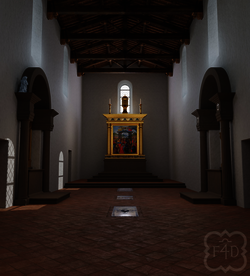Santa Maria degli Innocenti
Santa Maria degli Innocenti is the hospital church of Filippo Brunelleschi’s famous foundlings’ hospital, begun in 1419 and consecrated in 1451. Very little of the original church survives, as subsequent modifications and a wholesale renovation of the interior in neoclassical style by Bernardo Fallani in the 1780s have all but obliterated the interior of building. Nevertheless, a few original features - such as the stone frames of the clerestory windows, or the original truss-beam roof - and additional documentary and visual evidence provide glimpses of the fifteenth-century church’s simple design. Significantly, many of the paintings originally commissioned for the church are preserved to this day in the museum now housed in the hospital buildings, the Museo degli Innocenti.
The church of Santa Maria degli Innocenti was selected as a primary case example for the Florence4D project, as we set out to develop a workflow for our research-based 3D modelling. With the support of the museum, we were granted access to the church to conduct a full scanning campaign (using a Leika BLK360 portable scanner) and photogrammetry of the paintings in the gallery. The research team assembled the necessary documentary evidence to inform the process, and we brought these two strands of evidence together in the model that can be explored here (link to website).
In so doing we have proposed three historic periods of observation. The first shows the interior soon after the consecration in 1451, when Neri di Bicci’s Coronation of the Virgin and Saints was in place, while another proposes the interior towards the end of that century, following the important interventions overseen by the hospital prior, Francesco Tesori, which included the addition of two new altarpieces, including Domenico Ghirlandaio’s magnificent high altarpiece, depicting the Adoration of the Magi. A third step shows the church as it may have appeared in the second half of the sixteenth century, while the final option shows our scan of the building as it appears today. Hotspots in the web viewer provide summary information about key features, and provide links directly to our underpinning Omeka database which can be searched for additional information.
Through the map interface developed especially for this website you can access a ‘Tour’ that sets the hospital and its church in context. Different geodatasets present the location of the main hospitals documented in pre-modern city, including the Innocenti. Another allows you to explore and discover the property portfolio of the hospital, from which much of the rent income provided the funds to run the charitable institution. From there you can also explore the model itself in our web viewer, or dig further into the database for more detailed information.
We’ve recently been working with our technical partners Zubr, to extend the capabilities of the Hidden Florence 3D app (free on iOS and Android) to include a geolocated, 1:1 scale model of Santa Maria degli Innocenti that users can interact with in Florence, London and any other location. This new version of the app also includes hotspots, which allow us to present some of the new research on site. We’ve also created a video animation of the 3D model for the Museo degli Innocenti for display in the gallery. In these ways we’re making the research from the Florence4D project available to the wider public of visitors to museums and the historic centre of Florence. A series of research articles are forthcoming (see Publications), and will set out our research methods, workflow and initial findings from this important case example.
